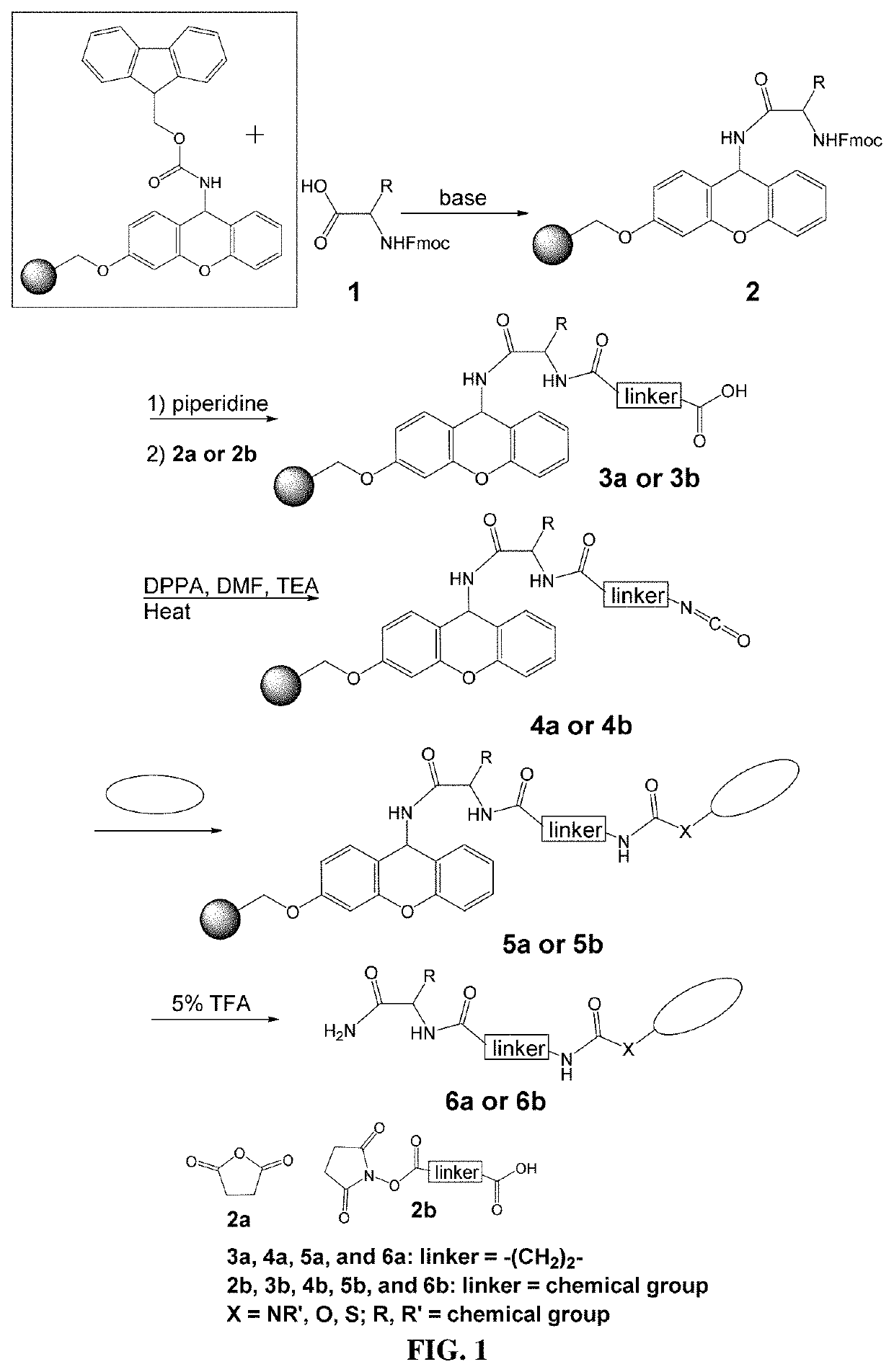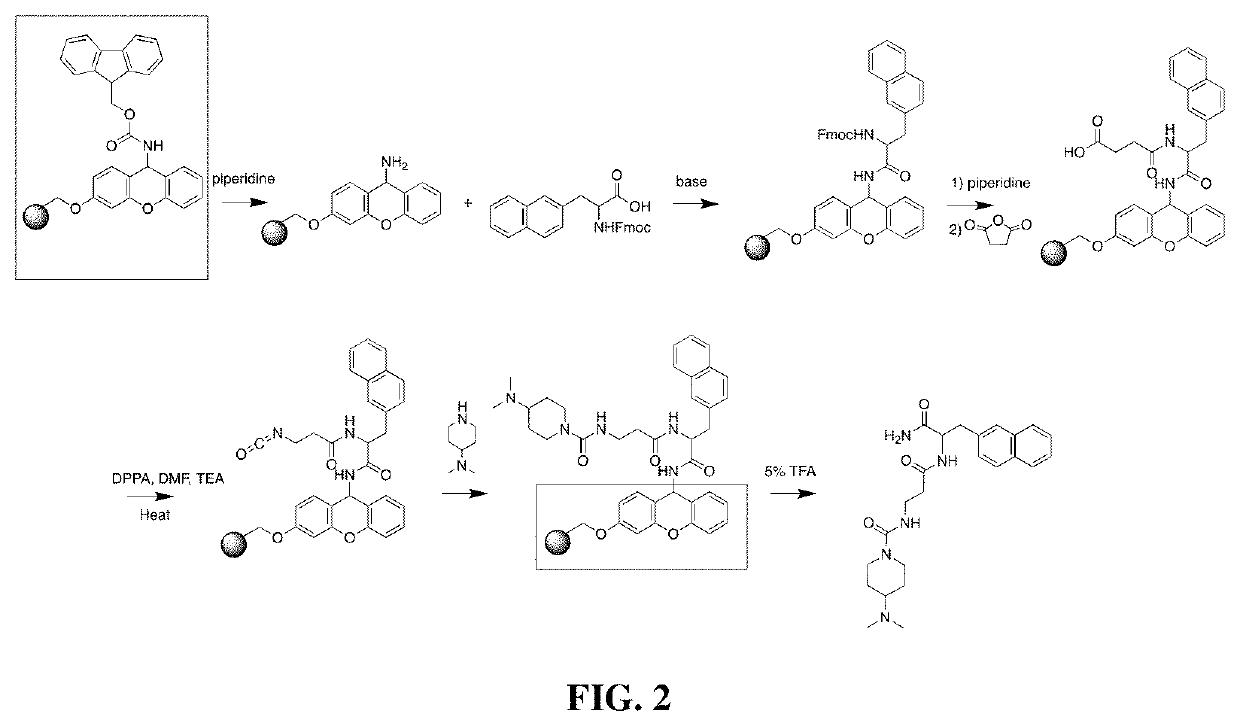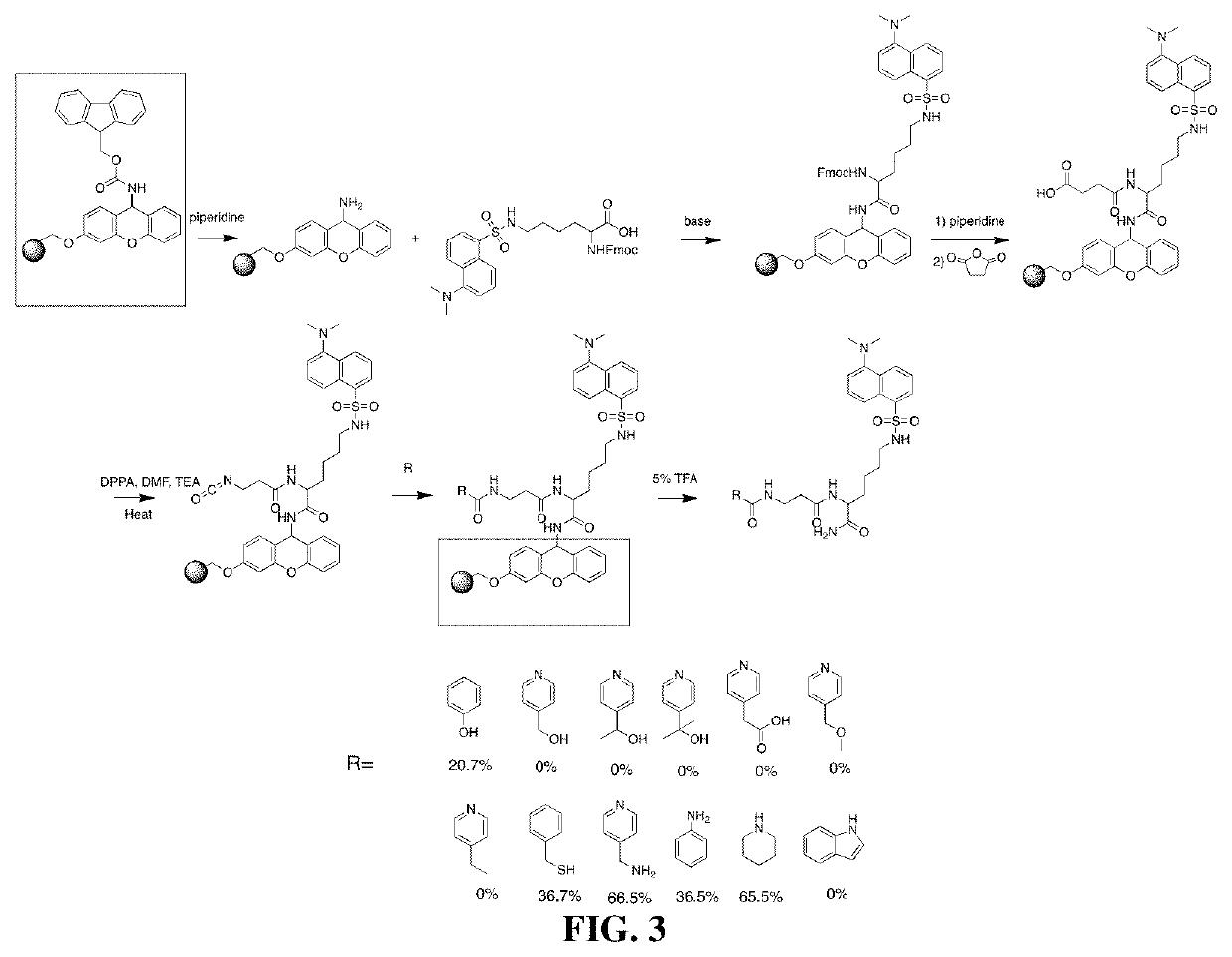High-throughput method to rapidly add chemical moieties to a small molecule library
a high-throughput, chemical moiety technology, applied in the field of chemical biology, can solve the problems of not being able to quickly modify a small molecule library, unable to achieve high-throughput screening of compounds generated by adding a desired chemical moiety to small molecules in an unbiased way,
- Summary
- Abstract
- Description
- Claims
- Application Information
AI Technical Summary
Benefits of technology
Problems solved by technology
Method used
Image
Examples
example 1
Functionalization of succinic anhydride Modified 3-(2-napthyl)-L-alanine with 4-(dimethylamino)piperidine
[0149]Materials and methods
[0150]Sieber amide resin (Novabiochem, Cat 8550080025, 0.62 mmol / g, 1 eq., 0.673 mmol) was swelled in anhydrous dimethylformamide (DMF) (10 mL) in a reaction syringe (Supelco, Cat #57118-U) for 30 minutes. DMF was removed under reduced pressure. The resin was deprotected by stirring with 20% v / v piperidine / DMF for 20 minutes. This was repeated. The resin was then washed three times with DMF. While the resin was being deprotected, N-Fmoc-3-(2-napthyl)-L-alanine (Combi Blocks Inc, Cat #SS-0101, 0.2 eq.) and hexafluorophosphate azabenzotriazole tetramethyl uronium (HATU) (0.2 eq.) were stirred in anhydrous DMF (2 mL) at room temperature for 30 minutes in a separate flask. The resin was reswelled in anhydrous DMF (10 mL). The N-Fmoc-3-(2-napthyl)-L-alanine and HATU solution was added to the resin. N,N-Diisopropylehylamine (DIPEA) (0.4 eq.) was then added to...
example 2
Modification of a Small Molecule with Different Nucleophilic Groups
[0153]Materials and methods
[0154]1,5-dansyl-L-lysine was synthesized as described in Hohsaka, et al. FEBS Letters. 2004. 560 (1-3), 173-177. Fmoc-1,5-dansyl-L-lysine was synthesized by dissolving 1,5 dansyl-L-lysine (3.7 mmol, 1 eq.) and Fmoc-Osu (Simga Aldrich Inc, 46920, 3.7 mmol, 1 eq.) in anhydrous acetone (20 mL) under argon atmosphere. DIPEA (2 eq.) was then added dropwise over 10 minutes. The solution was mixed for 20 hours. The reaction mixture was then diluted with ethyl acetate and washed with 5% NaSO4, then with aqueous saturated NaCl solution. The organic phase was dried over NaSO4, filtered and concentrated under reduced pressure. The residue was then purified by flash chromatography on silica (dichloromethane / methanol / acetic acid (89:10:1) to yield the Fmoc protected 1,5-dansyl-L-lysine as a yellow oil (944 mg, 42.5% over 2 steps). 1H NMR (400 MHz, (CD3)2SO) δ (ppm =8.46 (d, J=8.5 Hz, 1H), 8.32 (d, J=8....
example 3
Modification of AP1497, an FKBP12 Binder, with a Photoactivatable Group and “Click” Handle
[0164]Materials and Methods
Fmoc-pANA-OH was synthesized as described below.
Synthesis of 1-hydroxy-7-(trimethylsilyl)hept-6-yn-3-one (2)
[0165]n-Butyl lithium (1.71 mL, 4.01 mmol, 2.20 eq.) was added to a stirred solution of the ketal 1 (252 mg, 1.84 mmol, 1.00 eq.) in tetrahydrofuran (5.2 mL) at −78° C. The reaction mixture was stirred continuously for 1 hour at −78 ° C. Trimethylsilyl chloride (694 μl , 5.47 mmol, 3.00 eq.) was added dropwise to the reaction mixture at −78° C. The reaction mixture was warmed to 24° C. and stirred for 2 hours at 24° C. The reaction was quenched by addition of an aqueous hydrochloric acid solution (2.0 M, 10 mL). The resulting biphasic mixture was transferred to a separatory funnel. The aqueous layer was extracted with ether (3×10 mL) and the organic layers were combined. The combined organic layers were transferred back to the separatory funnel and washed with a...
PUM
| Property | Measurement | Unit |
|---|---|---|
| molecular weight | aaaaa | aaaaa |
| molecular weight | aaaaa | aaaaa |
| molecular weight | aaaaa | aaaaa |
Abstract
Description
Claims
Application Information
 Login to View More
Login to View More - R&D
- Intellectual Property
- Life Sciences
- Materials
- Tech Scout
- Unparalleled Data Quality
- Higher Quality Content
- 60% Fewer Hallucinations
Browse by: Latest US Patents, China's latest patents, Technical Efficacy Thesaurus, Application Domain, Technology Topic, Popular Technical Reports.
© 2025 PatSnap. All rights reserved.Legal|Privacy policy|Modern Slavery Act Transparency Statement|Sitemap|About US| Contact US: help@patsnap.com



